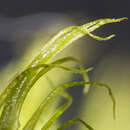Comments
provided by eFloras
Dicranum majus is the only North American species of the genus with a double row of guide cells. It is a distinctive species with oceanic tendencies and in North America it commonly grows in northern coastal localities on both sides of the continent, occasionally occurring inland in very moist habitats.
- license
- cc-by-nc-sa-3.0
- copyright
- Missouri Botanical Garden, 4344 Shaw Boulevard, St. Louis, MO, 63110 USA
Description
provided by eFloras
Plants large to robust, 5–8(–13) cm high, green or yellowish green, shiny, in loose tufts. Stems erect, or ascending, often branched, densely tomentose below. Leaves in several rows, falcate-secund when dry, erect-spreading when moist, lanceolate, 9–12 mm long, gradually narrowed to a long, subulate acumen; margins plane below, slightly incurved above, double-toothed above the middle; costa slender to rather stout, occupying ca. 1/10 – 1/5 the leaf base width, shortly excurrent, ending in a short hairpoint, serrate or ridged at back above; upper cells elongate, rectangular, incrassate, porose; basal cells long-rectangular, thick-walled, strongly porose, becoming more elongate at the margins; alar cells quadrate to short-rectangular, inflated, bi- to tristratose, pale brownish at the margins, hyaline within. Dioicous. Male plants dwarfed, located at the base of females. Perichaetial leaves sheathing at base, abruptly narrowed to a short hairpoint. Setae aggregated, 1–4 per perichaetium, 2.5–3.5 cm long, yellowish to yellowish brown, becoming reddish brown with age; capsules cylindric, 2–3 mm long, curved, inclined to horizontal, yellowish green to brownish, smooth or furrowed when dry and empty; opercula long-rostrate, 3.0–3.5 mm long; annuli none; peristome teeth dicranoid. Spores 14–33 µm in diameter, minutely papillose.
- license
- cc-by-nc-sa-3.0
- copyright
- Missouri Botanical Garden, 4344 Shaw Boulevard, St. Louis, MO, 63110 USA
Description
provided by eFloras
Plants in loose tufts, green to light green, glossy to somewhat dull. Stems 3-16 cm, naked or with a few whitish rhizoids, rarely moderately tomentose, rhizoids (micronemata) in rows above each leaf. Leaves somewhat sparse, falcate-secund or erect-patent, flexuose or straight, little changed when dry, usually smooth, (6-)8-11.5(-15) × 1-2 mm, concave proximally, tubulose above, from a lanceolate to ovate-lanceolate base, gradually narrowed to a long, falcate-secund or straight, acute apex; margins serrate in the distal half, sometimes slightly serrulate above to almost entire; laminae 1-stratose or with few 2-stratose regions on or near the margins; costa percurrent to shortly excurrent, 1/12-1/7 the width of the leaves at base, toothed distally or serrulate to nearly smooth on abaxial surface, with a double row of guide cells that is sometimes interrupted, two stereid bands extending to apex, adaxial epidermal layer of cells with some cells differentiated, the abaxial layer completely differentiated; cell walls between lamina cells not bulging; leaf cells smooth or abaxially prorate or toothed above; alar cells 2-stratose or multistratose, well-differentiated, not extending to costa; proximal laminal cells elongate, pitted, (42-)71-112(-140) × (5-)9-10(-15) µm; distal laminal cells shorter, linear to oval, pitted, (42-)47-61(-99) × (7-)10-11(-17) µm. Sexual condition pseudomonoicous; dwarf males among rhizoids of female plants; interior perichaetial leaves abruptly long-acuminate, convolute-sheathing. Seta 2.5-5 cm, aggregate, 2-5 per perichaetium, rarely solitary, yellow to light brown. Capsule 2-3.5 mm, arcuate, inclined to horizontal, smooth to faintly striate when dry, dark brown or yellowish brown; operculum 2-3 mm. Spores 14-19 µm.
- license
- cc-by-nc-sa-3.0
- copyright
- Missouri Botanical Garden, 4344 Shaw Boulevard, St. Louis, MO, 63110 USA
Distribution
provided by eFloras
Distribution: China, Korea, Japan, Russia, Europe, and North America.
- license
- cc-by-nc-sa-3.0
- copyright
- Missouri Botanical Garden, 4344 Shaw Boulevard, St. Louis, MO, 63110 USA
Habitat
provided by eFloras
Habitat: on rotten wood, soil or rocks.
- license
- cc-by-nc-sa-3.0
- copyright
- Missouri Botanical Garden, 4344 Shaw Boulevard, St. Louis, MO, 63110 USA
Synonym
provided by eFloras
Dicranum scoparium Hedw. var. majus (Turn.) Wahlenb., Fl. Carpat. Princ. 343. 1815.
Dicranum delavayi Besch., Rev. Bryol. 18: 88. 1891, syn. nov. Type. China: Yunnan, between Ho-kin and Ta-li (Da-li), Delavay 1867 (holotype BM).
- license
- cc-by-nc-sa-3.0
- copyright
- Missouri Botanical Garden, 4344 Shaw Boulevard, St. Louis, MO, 63110 USA
Dicranum majus
provided by wikipedia EN
- license
- cc-by-sa-3.0
- copyright
- Wikipedia authors and editors
Dicranum majus: Brief Summary
provided by wikipedia EN
Dicranum majus is a species of moss belonging to the family Dicranaceae.
It is native to the Northern Hemisphere.
- license
- cc-by-sa-3.0
- copyright
- Wikipedia authors and editors

